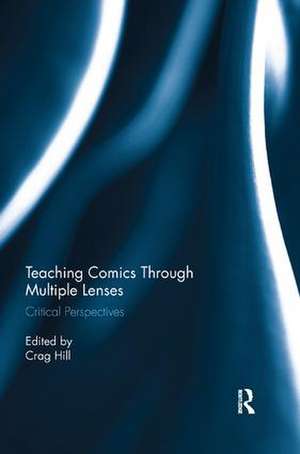Teaching Comics Through Multiple Lenses: Critical Perspectives
Editat de Crag Hillen Limba Engleză Paperback – 5 sep 2019
| Toate formatele și edițiile | Preț | Express |
|---|---|---|
| Paperback (1) | 381.72 lei 6-8 săpt. | |
| Taylor & Francis – 5 sep 2019 | 381.72 lei 6-8 săpt. | |
| Hardback (1) | 1216.52 lei 6-8 săpt. | |
| Taylor & Francis – 29 aug 2016 | 1216.52 lei 6-8 săpt. |
Preț: 381.72 lei
Nou
Puncte Express: 573
Preț estimativ în valută:
73.04€ • 76.27$ • 60.32£
73.04€ • 76.27$ • 60.32£
Carte tipărită la comandă
Livrare economică 15-29 aprilie
Preluare comenzi: 021 569.72.76
Specificații
ISBN-13: 9781138345300
ISBN-10: 113834530X
Pagini: 186
Ilustrații: 1 Illustrations, black and white
Dimensiuni: 152 x 229 x 13 mm
Greutate: 0.27 kg
Ediția:1
Editura: Taylor & Francis
Colecția Routledge
Locul publicării:Oxford, United Kingdom
ISBN-10: 113834530X
Pagini: 186
Ilustrații: 1 Illustrations, black and white
Dimensiuni: 152 x 229 x 13 mm
Greutate: 0.27 kg
Ediția:1
Editura: Taylor & Francis
Colecția Routledge
Locul publicării:Oxford, United Kingdom
Public țintă
Postgraduate and UndergraduateCuprins
Contents
Preface
1. Introduction: The Growing Relevance of Comics
Crag Hill
Section 1: Materiality and the Reading of Comics
2. Designing Meaning: A Multimodal Perspective on Comics Reading
Sean P. Connors
3. Multimodal Forms: Examining Text, Image, and Visual Literacy in Daniel Handler’s Why We Broke Up and Markus Zusak’s The Book Thief
Amy Bright
Section 2: Comics and Bodies
4. Illustrating Youth: A Critical Examination of the Artful Depictions of
Adolescent Characters in Comics
Mark A. Lewis
5. Just Like Us? LGBTQ Characters in Mainstream Comics
A. Scott Henderson
Section 3: Comics and the Mind
6. Telling the Untellable: Comics and Language of Mental Illness
Sarah Thaller
7. Christian Forgiveness in Gene Luen Yang’s Animal Crackers and Eternal Smile: A Thematic Analysis
Jake Stratman
Section 4: Comics and Contemporary Society
8. Poverty Lines: Visual Depictions of Poverty and Social Class Realities in Comics
Fred Johnson, Whitworth University, and Janine J. Darragh, University of Idaho
9. Can Superhero Comics Defeat Racism?: Black Superheroes "Torn between Sci-Fi Fantasy and Cultural Reality"
P.L. Thomas
10. Teaching Native American Comics with Post-Colonial Theory
Lisa Schade Eckert
Section 5: Endpoints
11. Crag Hill
List of Contributors
Additional resources were compiled by Shaina Thomas.
Preface
1. Introduction: The Growing Relevance of Comics
Crag Hill
Section 1: Materiality and the Reading of Comics
2. Designing Meaning: A Multimodal Perspective on Comics Reading
Sean P. Connors
3. Multimodal Forms: Examining Text, Image, and Visual Literacy in Daniel Handler’s Why We Broke Up and Markus Zusak’s The Book Thief
Amy Bright
Section 2: Comics and Bodies
4. Illustrating Youth: A Critical Examination of the Artful Depictions of
Adolescent Characters in Comics
Mark A. Lewis
5. Just Like Us? LGBTQ Characters in Mainstream Comics
A. Scott Henderson
Section 3: Comics and the Mind
6. Telling the Untellable: Comics and Language of Mental Illness
Sarah Thaller
7. Christian Forgiveness in Gene Luen Yang’s Animal Crackers and Eternal Smile: A Thematic Analysis
Jake Stratman
Section 4: Comics and Contemporary Society
8. Poverty Lines: Visual Depictions of Poverty and Social Class Realities in Comics
Fred Johnson, Whitworth University, and Janine J. Darragh, University of Idaho
9. Can Superhero Comics Defeat Racism?: Black Superheroes "Torn between Sci-Fi Fantasy and Cultural Reality"
P.L. Thomas
10. Teaching Native American Comics with Post-Colonial Theory
Lisa Schade Eckert
Section 5: Endpoints
11. Crag Hill
List of Contributors
Additional resources were compiled by Shaina Thomas.
Notă biografică
Crag Allen Hill is Assistant Professor of English Education at Jeannine Rainbolt College of Education, University of Oklahoma, USA.
Recenzii
"For a relatively compact book, Teaching Comics covers substantial ground... Teaching Comics usefully illustrates the importance of comics as a medium and area of study on its own, apart from other media. Though this does not come across as a campaign for legitimacy, it is clear that these scholars have a vested interested in growth and development of this area."
— Jacinta Yanders, Studies in 20th & 21st Century Literature
"This edited volume provides teachers with a series of theoretical approaches applied to a variety of comics to help them in their own practice. It touches on an impressive breadth of graphic texts and theories. meant to open up new ways of thinking about using comics in the classroom. "
— John D. Benjamin, Seminar: A Journal of Germanic Studies, UTP Journals
— Jacinta Yanders, Studies in 20th & 21st Century Literature
"This edited volume provides teachers with a series of theoretical approaches applied to a variety of comics to help them in their own practice. It touches on an impressive breadth of graphic texts and theories. meant to open up new ways of thinking about using comics in the classroom. "
— John D. Benjamin, Seminar: A Journal of Germanic Studies, UTP Journals
Descriere
Drawing from range of current scholarship demonstrating that comics are an expressive medium whose moves (structural and aesthetic) may be shared by literature, the visual arts, and film, possessing qualities these other mediums do not, this volume, written by teachers and scholars of comics for instructors, bridges research and pedagogy, providing models of critical readings around a variety of comic works.
